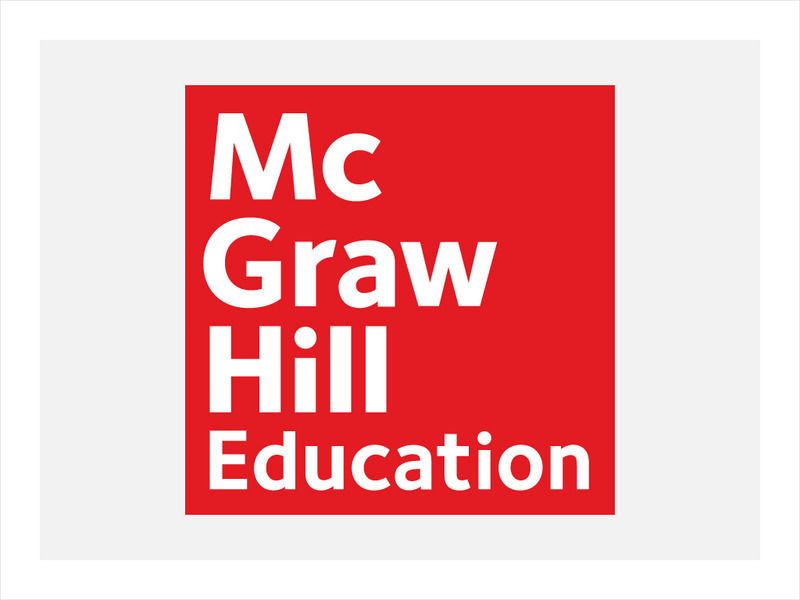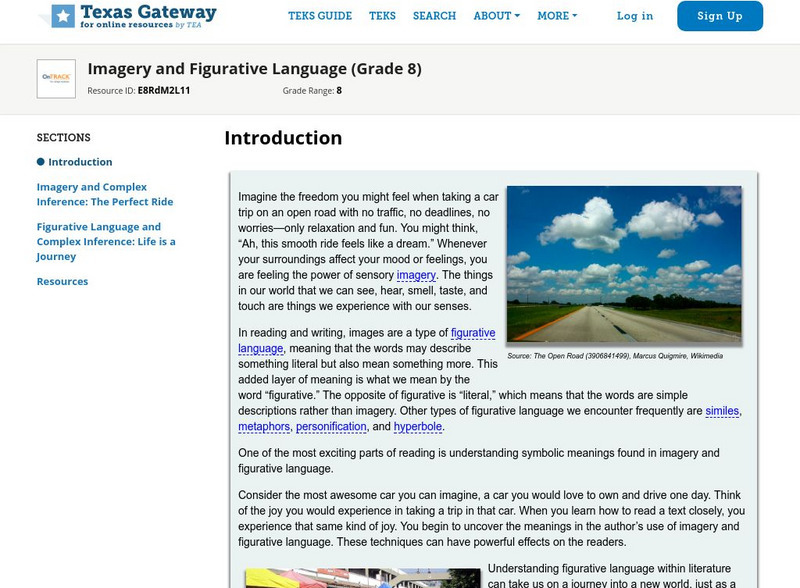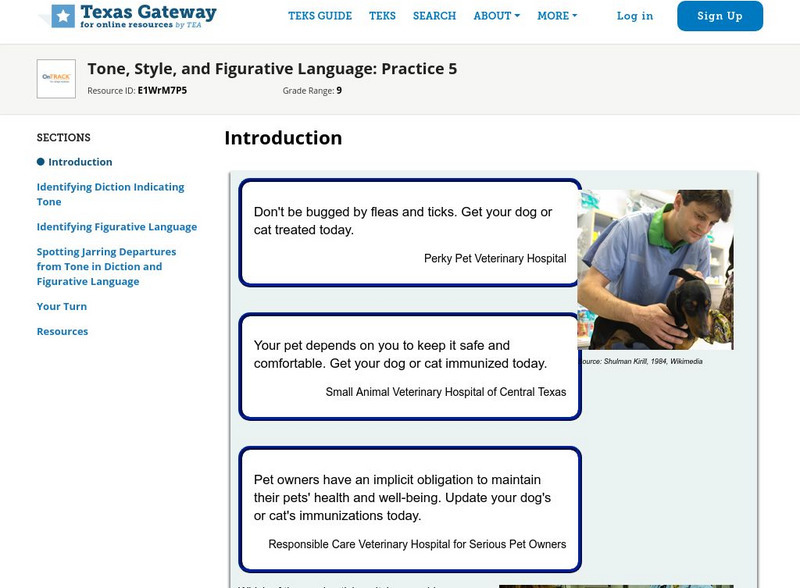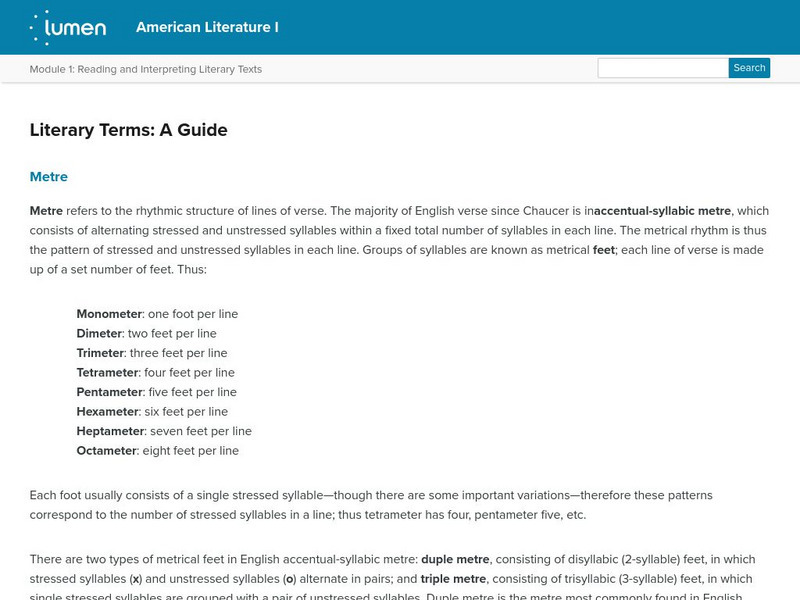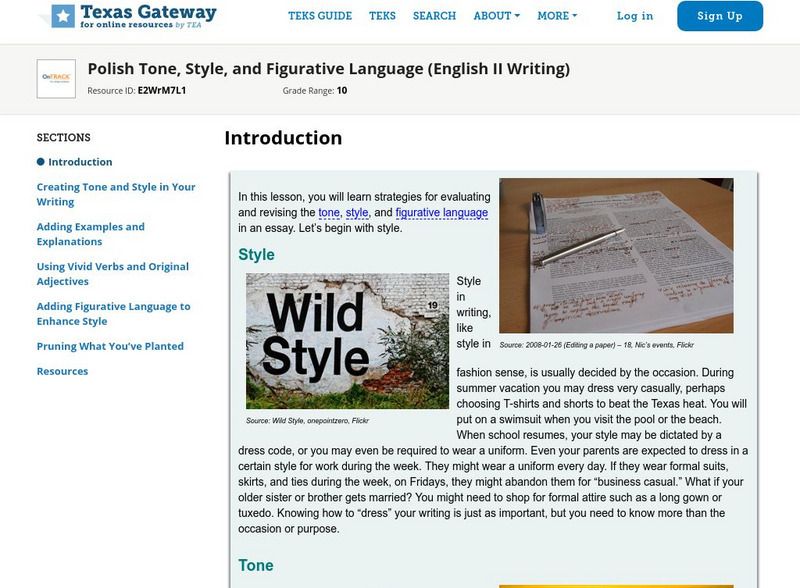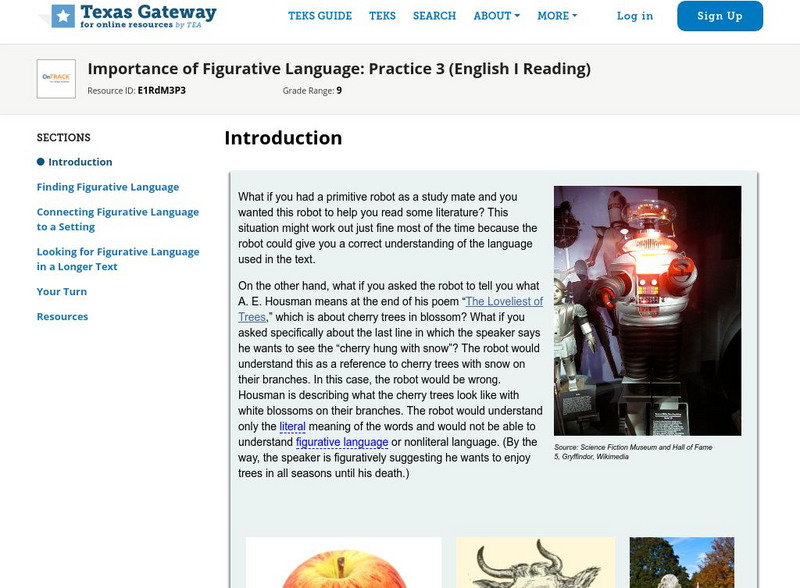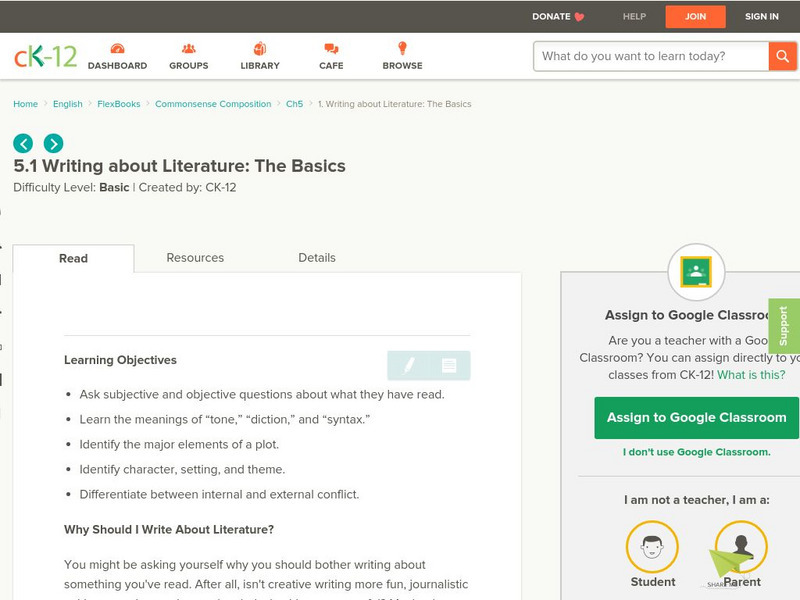McGraw Hill
Mc Graw Hill: Informational Text: Craft and Structure: Figurative Language
Explains what figurative language is and how to determine its meaning. Also provides a practice exercise.
Other
Study Guide: Literary Terms: English 11
This is a glossary of literary terms designed for English 11: semester 1 and semester 2.
Texas Education Agency
Texas Gateway: Imagery and Figurative Language (Grade 8)
Make complex inferences and use textual evidence such as imagery and figurative language to support understanding.
Texas Education Agency
Texas Gateway: Applying Word Study Strategies (English I Reading)
Apply previous lessons, (1) Linguistic Roots and Affixes, (2) Denotation and Connotation, (3) Origins and Meanings of Foreign Words, (4) Cognates, and (5) Reference Materials, to improve fluency and comprehension.
Texas Education Agency
Texas Gateway: Importance of Figurative Language: Practice 3 (English I Reading)
Read a text and understand how the figurative language of a literary work contributes to its historical and cultural setting.
Texas Education Agency
Texas Gateway: Literary Terminology: Practice 5 (English I Reading)
[Accessible by TX Educators. Free Registration/Login Required] You will practice using terminology critical for comprehension, interpretation, and analysis of poetry, drama, and fiction.
Texas Education Agency
Texas Gateway: Development of Characters Through Literary Devices
Rcognize how literary devices such as character foils can create complex characters in a short story.
Texas Education Agency
Texas Gateway: Close Reading of Poetry: Practice 3 (English Ii Reading)
Read carefully in order to identify allusion, imagery, metaphor, and symbolism, and evaluate their impact on the meaning of a text.
Texas Education Agency
Texas Gateway: Tone, Style, and Figurative Language: Practice 5
Mark examples of figurative language and the diction that indicate tone.
Lumen Learning
Lumen: Reading and Interpreting Literary Texts: Literary Terms: A Guide
This is a guide to poetic literary terms such as meter and an explanation of several types of meter, types of stanzas, types of rhyme, etc.
Texas Education Agency
Texas Gateway: Denotation and Connotation (English I Reading)
This lesson focuses on denotation and connotation including the abilty to distinguish words according to their emotional or cultural meaning. Your ability to do so can help you understand the author's purpose or more about a character in...
Love To Know Media
Your Dictionary: Literary Terms Lesson Plan
This is a lesson plan for teaching the seven literary terms used in poetry: simile, metaphor, alliteration, imagery, hyperbole, personification, and onomatopoeia.
Love To Know Media
Your Dictionary: Literary Terms to Know in Seventh Grade
This site lists and briefly defines the literary terms 7th graders should know including types of writing, literary devices, sound devices, figurative language, and parts of a story,
Quizlet
Quizlet: Literary Elements Definitions
Learn about 32 different literary elements with flashcards, quizzes, and interactive games.
Ted Nellen
Cyber English (By Ted Nellen): Literary Terms
This is an extensive glossary of literary terms.
Better Lesson
Better Lesson: L.3.5a: Distinguish Literal and Nonliteral Meanings of Words
Links to 18 lessons and activities that build student skills in standard L.3.5a: Distinguish the literal and nonliteral meanings of words and phrases in context (e.g., take steps).
Texas Education Agency
Texas Gateway: Polish Tone, Style, and Figurative Language
[Accessible by TX Educators. Free Registration/Login Required] In this lesson, you will learn strategies for evaluating and revising the tone, style, and figurative language in an essay. It also includes practice exercises.
Texas Education Agency
Texas Gateway: Importance of Figurative Language: Practice 3 (English I Reading)
[Accessible by TX Educators. Free Registration/Login Required] In this lesson, you will sharpen your skill in reading figurative language and in connecting it with the historical and cultural settings in the text.
CK-12 Foundation
Ck 12: 6.1 Writing About Literature: Analyzing Prose
[Free Registration/Login may be required to access all resource tools.] Learn to analyze prose by understanding connotation and denotation, identifying metaphors and similes, looking for repetition, and finding imagery in a text.
CK-12 Foundation
Ck 12: 5.1 Writing About Literature: The Basics
[Free Registration/Login may be required to access all resource tools.] Learn the basics of how to write about literature by asking subjective and objective questions; use tone, diction, and syntax; identify plot elements, and...
Other
Fu Jen Univ.: Poetic Elements: Denotation and Connotation: Figures of Speech
This site gives short definitions of the terms denotation and connotation. Also gives definitions for many figures of speech. Finally, includes discussion and study questions for a few poems at the bottom of the page. L.11-12.5b Nuance
Alabama Learning Exchange
Alex: Plath, Personification, and Figurative Language
This project based activity will use Sylvia Plath's poem, "Mirror", to examine the use of personification and figurative language. The activity may also incorporate the use of technology to produce a multimedia project. This allows...
Alabama Learning Exchange
Alex: Figurative Language
This lesson used a slideshow presentation to explain the difference between similes and metaphors. Students are challenged to identify these figurative elements in literature and then create some themselves.
PBS
Pbs Learning Media: Literary Elements and Techniques: Figurative Language
Discover how authors use figurative language to enhance their writing and explore the differences between similes and metaphors in this animated video [3:37] from WNET. Discussion questions below help students to further apply their...


